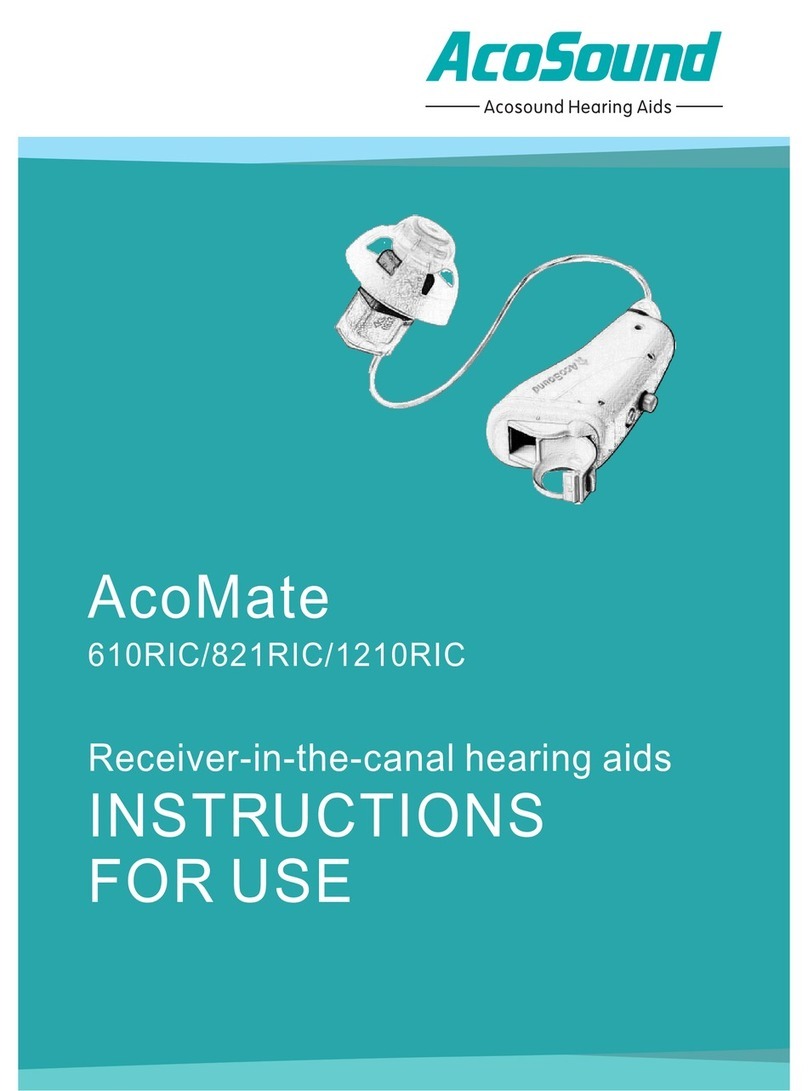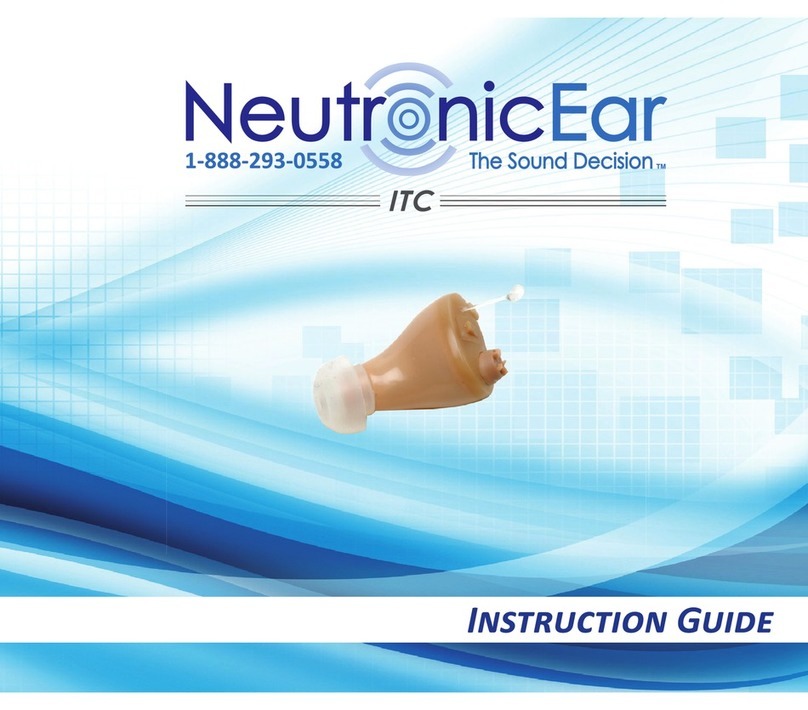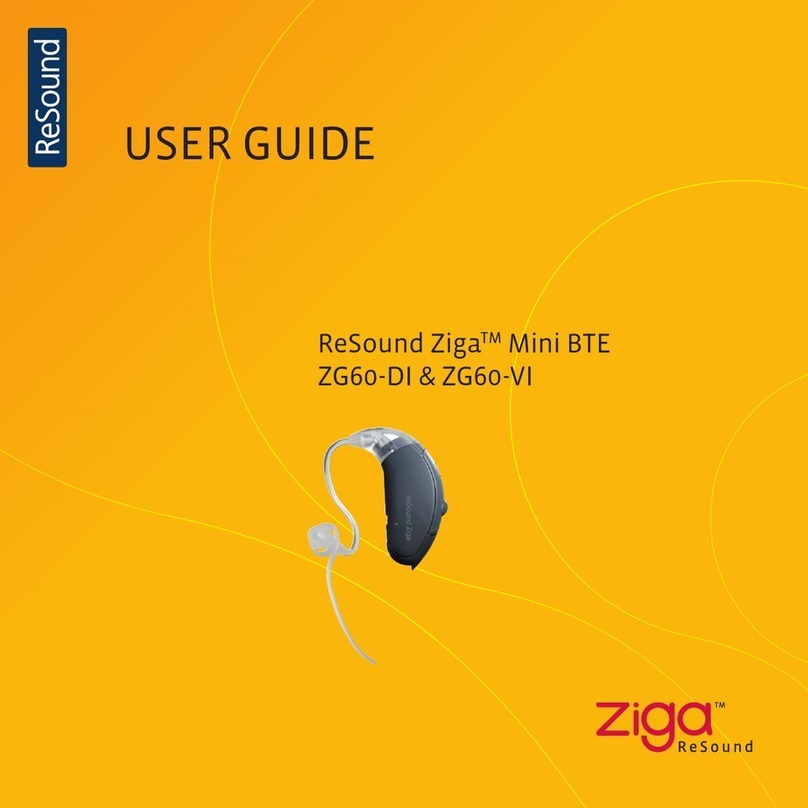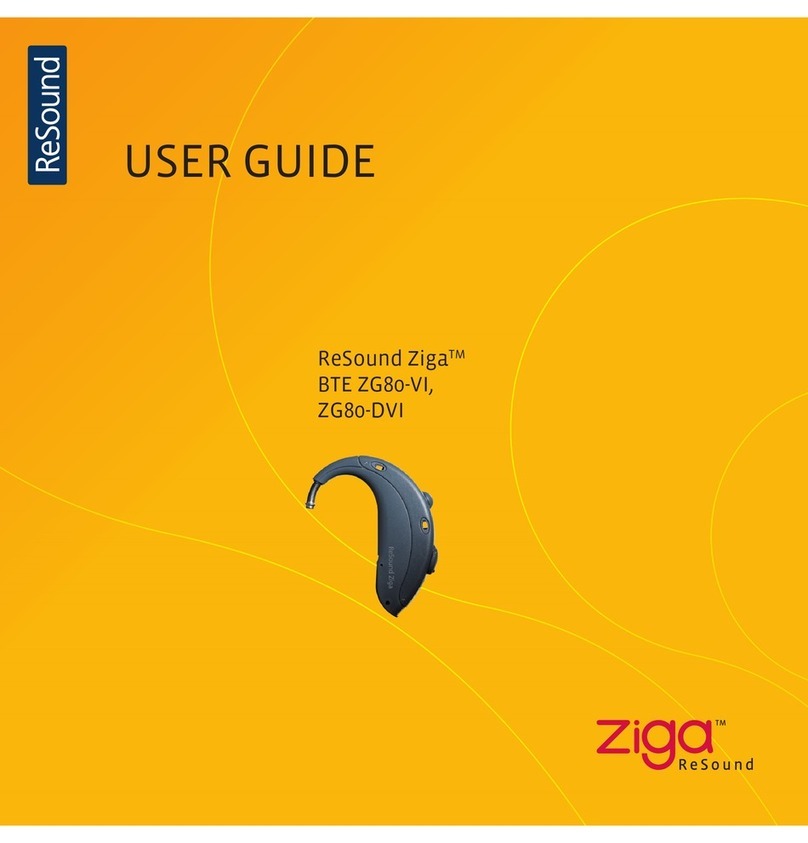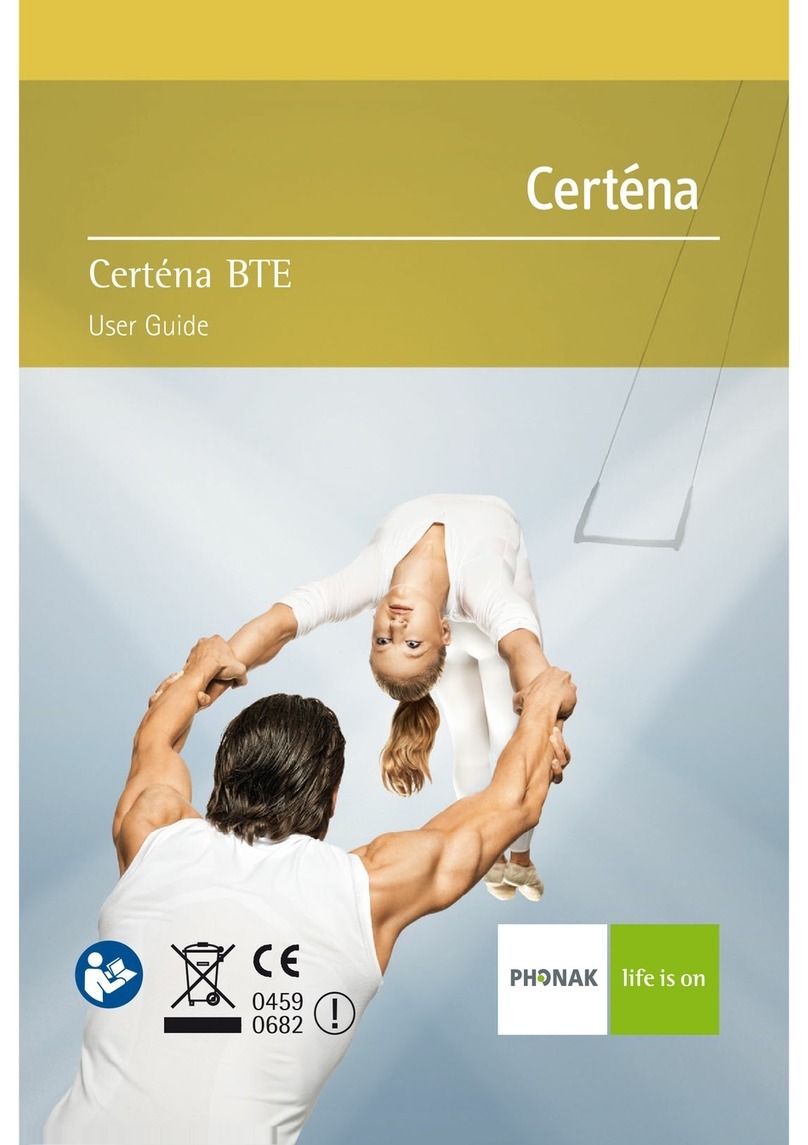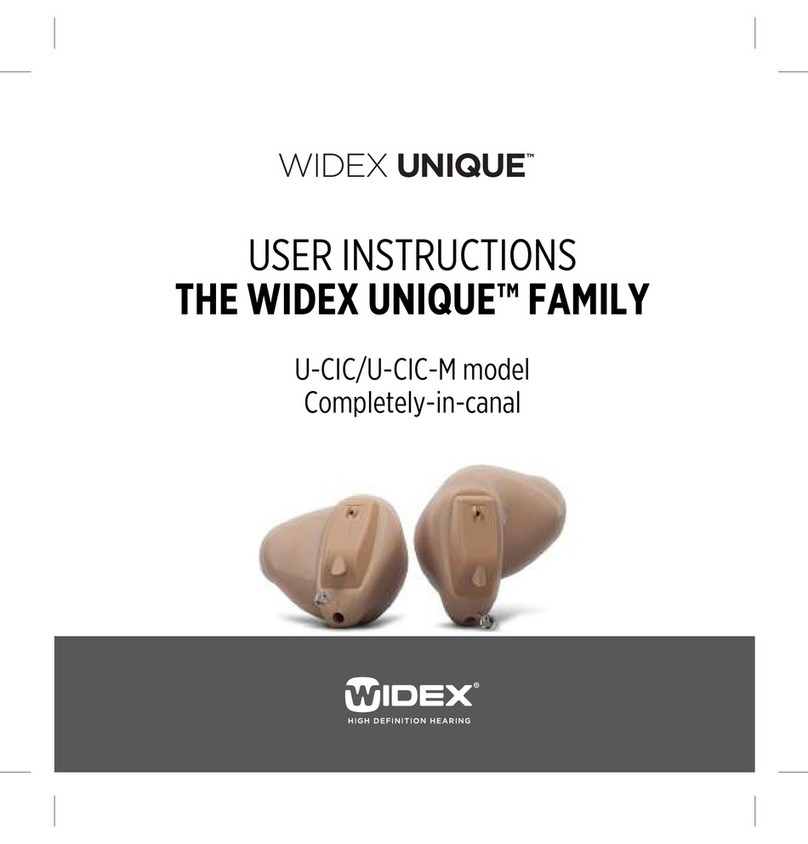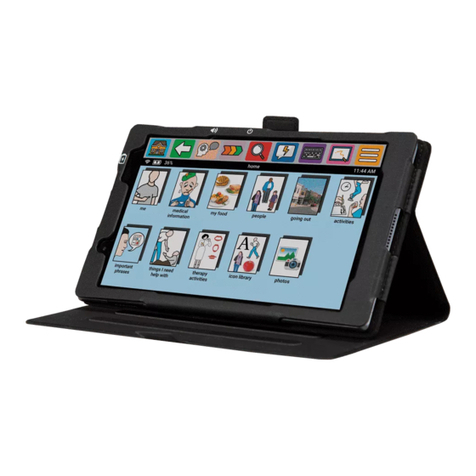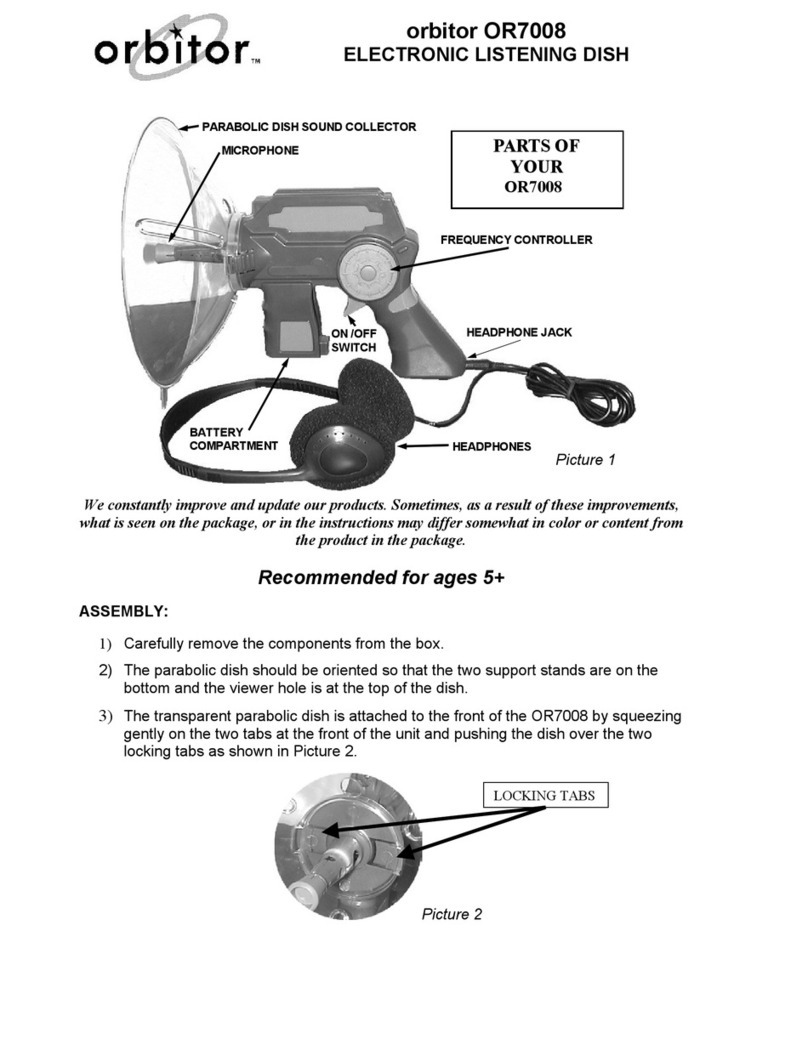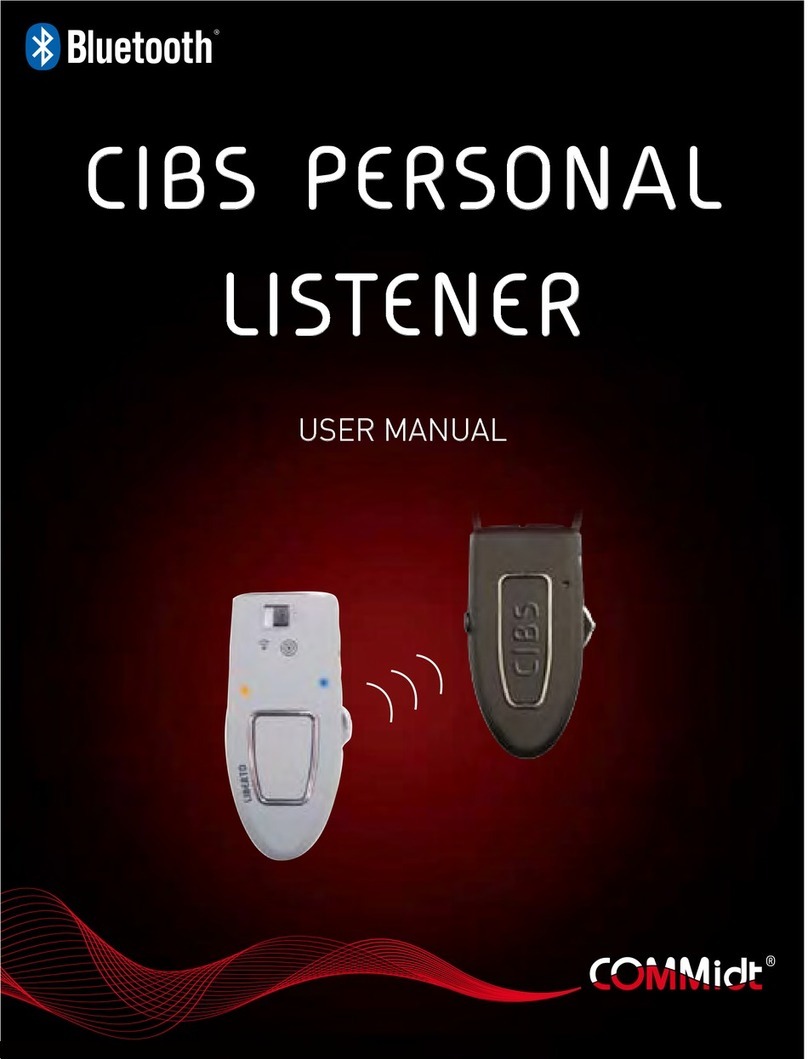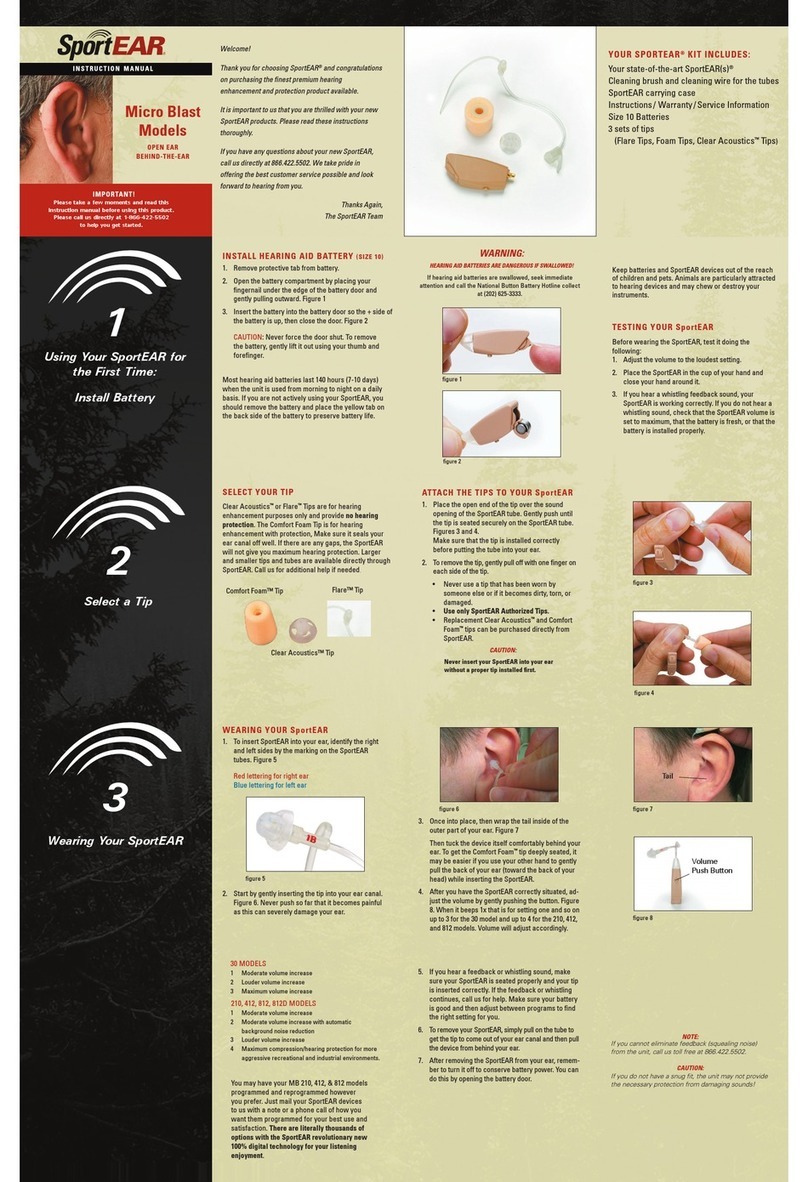AcoSound Leya-W-BTE-M User manual

Danshi
Registered persons:ACOSOUND TECHNOLOY(CANADA) INC
Name of Production Enterprise:ACOSOUND TECHNOLOY(CANADA) INC
Production address:Room 601, Building 5,998 Wenyi West Road, Wuchang
Street, Yuhang District, Hangzhou
Registered address:Room 601, Building 5,998 Wenyi West Road, Wuchang
Street, Yuhang District, HangzhouTel:0571-81021867 Fax:0571-8121869
Email:[email protected]
National toll-free hotline:4008-622282
1
Hearing aids for the back of the ear
Instruction Manual
ACOSOUND TECHNOLOY(CANADA) INC
2

Hearing aids for the back of the ear
User instructions
Directory
Ⅰ、Description of components-------------3 Ⅳ、Product characteristics------------------10
Ⅱ、Operational guidelines------------------4 V、Daily maintenance------------------------11
1、Wear method------------------------4 VI、Simple Fault Checklist--------------------12
1.1 Wear a hearing aid------------------4 VII、Rehabilitation guidance----------------13
1.2 Remove the hearing aid------------5 VIII、Other considerations------- ----- -----15
1.3 Contact wear -------------------------5 IX、Remarks----------------------------------17
2、On/off function---------6 X、Work and storage transport requirements---------18
3、Procedure selection---------------6 XI、Technical parameters---------------------18
4、Replacement of batteries--------------7 XII、Maintenance------------------------25
5、Phone calls----------------------9 XIII、disclaimer------------------------26
Ⅲ、 Scope of application, contraindications, recommendations
Service life--------------10
4
3
Ear back hearing aid is a precision sensitive medical
electronic product, so please read the book carefully
before use, and follow the instructions to operate,
improper operation may damage the hearing aid.
Ⅰ.Description of components
Remarks:
1. Basic structures include an input transducer (microphone), a signal conditioning unit (DSP), an
output transducer (receiver), a battery, an ear-back housing (skin contact part behind the human ear), an
ear hook, other auxiliary structural components, and a sound control knob (optional),fine-tuning knob
(optional), program selection button (optional).
2. the size of earplugs, users can determine the size of earplugs according to their actual ear canal
situation, we have prepared three sizes of earplugs for you to choose from.
3. the length of the tube, the user can bring the earplugs into the ear, then hang the machine behind
the ear, determine the position of the tube intersecting with the machine, cut off the extra tube, and put
it into the ear hook.
4. Users can rotate the catheter to the right angle according to their left and right ears.
II. Operational guidelines
1、Wear method
1.1Wear a hearing aid
Connect the acoustic outlet of the hearing aid to the standard
earplug, please pay attention to distinguish the left and right ear
correspondence;
Load the corresponding battery and gently close the hearing aid
battery door. It is best not to close completely (see on / off
function) when the hearing aid is not working. )
Pinch the earplugs with your forefinger and thumb and align
them to the ear canal, which will help you bring them more easily;
The upper part of the earbuds is gently backward and moving
forward so that the earbuds match comfortably with the ear canal;
Place the hearing aid behind the ear. Move up and down to

5
determine whether the earplugs are in the right position. Open
mouth a few times, can help you feel the position of earplugs is
correct;
6
Make sure to wear in place, completely close the battery door, hearing aids start
working.
You can still wear it while the hearing aid is on, but during the wear you may hear from
the feedback.
1.2 Remove the hearing aid
When you remove the hearing aid money, it is recommended that you slightly open the
battery door to stop the hearing aid first; lift the hearing aid from the ear and hang it in
your ear; gently hold the ear plug with your index finger and thumb; pull the ear plug out
along the ear canal (be careful not to pull the hearing aid or catheter); then remove the
ear plug with the hearing aid; while removing the hearing aid, another hand is under the
auricle to help you remove the hearing aid.。
1.3Practice wearing
It takes practice to wear and remove the hearing aid. But practice makes perfect, after a
period of time can skillfully operate hearing aids. Use your time at home, start with a
mirror, preferably on the table, giving your arm a fulcrum,It is more convenient to operate.
If you have any questions about how to wear and remove your hearing aids, consult your
matchmaker
7
2. on/off function
You can turn off / turn on the hearing aid by opening / closing the battery bin door.
Open the battery bin and the hearing aid stops working. Fully close the battery door and
the hearing aid starts working.
3 Procedure selection
Up to four listening programs can be used in the ear-back hearing aid of the Echo
series. Please specify the number of hearing aids you have.
With the program switch button, you can easily select the listening program you want
to use.
When the switch defaults to the first listening program, through the "program switch
button ", switch to the second listening program, the hearing aid issued" Didi "two
sound prompt.
When the hearing aid is turned off again (see on / off function), the system
automatically switches to the listening program.
The first program is suitable for use in a quiet environment (saturated listening needs,
not suitable for long-term wear), and the fourth program is nused when there is a need
for high frequency (such as listening to music). Please choose according to your
environmet 8
2.replacement batteries
When the battery is insufficient, the hearing aid makes a "drop" sound. Give a low power
prompt until it stops working. In order not to affect your normal life, it is recommended
that you carry a new battery with you. Please refer to the illustration:
Type of hearing aid using zinc empty battery refer to "technical parameters ";
When replacing the battery should be lightly pushed, do not forcibly close the battery
bin, lest damage the hearing aid;
If the battery power is too low, the hearing aid will not work properly, in order to
ensure your normal use, please replace the new battery in time;
If you can't use the hearing aid for a long time, remove the battery so as not to corrode

Before using the new zinc empty battery, please remove the adhesive sticker attached to
the positive electrode of the battery (as shown);
9
the hearing aid.
Use of caveats:
◆Batteries should be kept away from children and pets;
◆Do not put waste batteries into fire, lest cause explosion;
◆Do not put the battery and medicine together, do not put the battery into the
mouth;
◆Swallowing the battery can be life-threatening, if accidentally swallow the battery,
please immediately seek medical attention;
◆Please treat waste batteries to protect the environment according to environmental
regulations;
◆It is suggested that waste batteries be sent to places where waste batteries are
professionally recycled for disposal by sanitation workers or to buried areas where
waste batteries are prescribed by the state for burial;
◆Scrap machines should be treated in accordance with environmental regulations to
protect the environment. 10

2.phone calls
You can answer the phone using the Echo series ear-back hearing aid, but you need more
skills and practice to use it better. Since the microphone (sound input port) of the back
hearing aid is not directly opposite the ear canal above the auricle, the receiver should be
close to the top of the auricle when answering the phone.
When using the phone, if there is a feedback howling, please speak the phone receiver a
little away from the hearing aid.
The steps to clean earplugs are as follows:
◆Please separate the earplug from the guide tube of the hearing aid before cleaning the
earplug
◆If there are left and right earplugs, please pay attention to distinguish;
◆Use small brushes and soft dry cloth to clean earwax on earplugs. If necessary, but use
soft cleaning agents such as water, flexible soap wipe;
◆You can wash earplugs with water. Note: do not use water or other liquids to clean the
hearing aid fuselage;
◆Please make sure the water on the tube and earplug has been blown dry before
reconnecting the earplug with the hearing aid;
◆The connection between earplugs and hearing aids should correspond to the left and
right ears.
11
III.Scope of application, contraindications, recommended useful life
Scope of use: for hearing loss patients hearing compensation.
Contraindications: acute external otitis media, euritis, chronic suppurative otitis media
(in the period of purulent infection), acute suppurative otitis media patients allergic to
product materials, etc.
Recommended replacement years: five years
Scope of use: for hearing loss patients hearing compensation.
Contraindications: acute external auditory canal inflammation, euritis, chronic
suppurative otitis media.
IV.Product characteristics
1. by type of shock protection: internal power
2. Classification by type of click: B type
3. by level of protection against incoming fluids: general equipment
4. Classification by safety in the case of flammable anaesthetic gas mixed with air or
flammable anaesthetic gas mixed with oxygen or nitrous oxide: AP、APG type
5. Hearing aids :1.4 V power supply
12

V. Routine maintenance
Hearing aids are sophisticated and sensitive electronic devices, and it is important to keep
them clean and dry.
Wipe off grease or moisture from the shell with soft dry cloth or cotton paper. If the
hearing aid eats fish wet environment or often in contact with sweat, please open the
hearing aid battery bin door at night and put it in a drying box with desiccant with
earplugs. Please refer to the drying box for details about the use of desiccant.
In order to better use hearing aids, please pay attention to the following points in daily
use:
Do not place hearing aids in the hot sun, close to the stove or other heat sources;
Do not shower, swim, rain or humidity Use of hearing aids in the environment, such as
sauna and steam bath;
Carefully protect the hearing aid from falling to the ground or other hard plane.
Avoid contact with chemicals or strong detergents.
13
VI.Simple Fault Checklist
Failure
Reasons
Processing methods
No boot
Battery is dead or too low
Out of the mouth
Boot
Replace batteries and place them
correctly
Replace baffle and clean hearing aid
No hearing aids shut down at
night
Battery over the validity
period
Hearing aids dampened
Turn off hearing aids at night
Check battery life
Use desiccant or consult a matchma
Low volume, low battery
power
Clogging of microphone
inlet, dirty plugging of
speaker outlet, alteration of
hearing loss, earwax
accumulatio
Increase volume, replace new
batteries, replace microphone baffles,
replace speaker baffles, consult with
matchmaker, clean ear canal or consult
a docto
Low battery power
Replacement of new batteries
The above method can not solve your hearing aid problem, please consult or repair the
matchmaker.
14
Failure
Reasons
Processing method
Noise
Battery power is too low
Replacement of batteries
Whistling
Excessive volume adjustment
Turn down the volume
The voice is
Battery power is too low, hearing loss
For battery replacement,
Personal plans:
The first week, use hearing aids at home for 1-2 hours, re-familiarize and distinguish all
kinds of sounds, even if some sounds you are not familiar with or understand, it does
not matter, please stick to practice. Try to listen to all kinds of water (it is difficult to
adapt to watching TV and listening to the phone);

not clear
changes
please consult the
matchmaker
The above method can not solve your hearing aid problem, please consult or repair the
matchmaker.
VII.Rehabilitation guidance
First wear hearing aid adaptation plan principles:
Time from short to long, use environment from quiet to noisy, peace of mind, patience
to adapt!
15
The second week, you can take a walk in the garden, relatively quiet environment for 4
hours, feel different sounds, try to listen to birds, leaves swing, wind blowing and so on;
In the third week, try to go to less noisy public places (streets with few vehicles), or talk
to unfamiliar people, don't worry, can be heard by increasing the volume, the important
thing is exercise and familiarity;
The fourth week, if the previous exercise and adaptation is relatively smooth, you can
rest assured to use, remember to check the store and debug the new parameters
(because the initial debugging is to make you adapt). Watching TV, answering the phone
and so on need longer exercise, normal listening people will not hear a lot of lines and
words.
After the adaptation period, in addition to sleep, exercise, bath, and cleaning and
maintenance time, encourage more hearing aids.
16
VIII.Other considerations
◆Professional examination and hearing test should be carried out before hearing aids are
tested and used under the guidance of a doctor or a professional hearing aid teacher.
◆Moisture-proof, shockproof, high temperature.
◆Do not immerse the hearing aid in any liquid. Remove the hearing aid before
swimming and washing. After swimming or washing, wait until the ear canal is dry before
wearing the hearing aid.
◆After removing the hearing aid in the evening, it should be placed in a box containing
desiccant to avoid light, high temperature, high humidity and collision.
◆Keep the external surface of the hearing aid clean and often clean the earwax in the
earplugs.
◆The function and volume control switch should be used correctly, so as to avoid
excessive force and excessive force.
◆Do not use this product for any purpose other than the instructions in this manual.
◆Do not use any accessories or components produced by other manufacturers or
specially recommended by AI. If such parts or accessories are used, your warranty will
expire.
◆If this product is used by people with unsound limbs, mental disorders or lack of
relevant experience and knowledge, they need to be supervised or directed by people
responsible for their safety.
◆Failure hearing aids must be repaired by qualified professional maintenance
personnel, do not disassemble, unauthorized processing, otherwise the warranty is
invalid. If there is a problem with hearing aids, please contact the matchmaker or
manufacturer. Regular maintenance of hearing aids by the tester can reduce the amount
of hearing aids repair.
◆For hearing aids with a maximum output of more than 132 dB SPL, high intensity

◆Hearing aids should be regularly sent to the testing center for maintenance and
inspection to ensure that the hearing aids are in good condition.
17
sound output signals may cause residual hearing damage. Please use them carefully or
adjust the volume at the advice of the matchmaker.
18
This device complies with part 15 of the FCC Rules. Operation is subject to the following
two conditions: (1) This device may not cause harmful interference, and (2) this device
must accept any interference received, including interference that may cause undesired
operation.
Any Changes or modifications not expressly approved by the party responsible for
compliance could void the user's authority to operate the equipment.
This equipment should be installed and operated with a minimum distance of 0mm
between the radiator and your body.
19
This equipment has been tested and found to comply with the limits for a Class B digital
device, pursuant to Part 15 of the FCC Rules. These limits are designed to provide
reasonable protection against harmful interference in a residential installation. This
equipment generates uses and can radiate radio frequency energy and, if not installed
and used in accordance with the instructions, may cause harmful interference to radio
communications. However, there is no guarantee that interference will not occur in a
particular installation. If this equipment does cause harmful interference to radio or
television reception, which can be determined by turning the equipment off and on, the
user is encouraged to try to correct the interference by one or more of the following
measures:
-- Reorient or relocate the receiving antenna.
-- Increase the separation between the equipment and receiver.
-- Connect the equipment into an outlet on a circuit different from that to which the
receiver is connected.
-- Consult the dealer or an experienced radio/TV technician for help.
20

IX.Remarks
List of accessories
Replacement cycle
Replacement methods
Battery
Usually a battery is used for
about a week
Refer to Operation Guide 4 to
replace batteries
Earplugs
About a year
Please refer to Operation Guide
1
Small brush
5 years
Description of symbols in labels
Waterproof: hearing aids are sensitive electronic devices, please pay attention to
waterproof, moisture-proof.
Classification of types of electric shock: type B.
Environmental protection: hearing aid battery is a disposable zinc empty battery, after
use, please pay attention to environmental protection.
21
X.Working, Storage and Transport Conditions
Normal working conditions:
Temperature :-20℃-40℃Humidity :30-90
Atmospheric pressure :86-106 Kpa Battery voltage: V 1.4
Environmental conditions for transport and storage:
Transport conditions: shockproof, anti-fall, moisture-proof storage conditions: dry,
clean, normal temperature
Temperature :0℃-38℃; Humidity :<80; Atmospheric pressure :86-106 Kpa
22

XI.Technical parameters Product performance parameters
Product model
Product performance parameters
High frequency mean
saturated sound pressure level
High frequency average full gain
Leya-W-BTE-M
118
38
Celesto-W-BTE-M
118
38
Lexie BTE-M
118
38
XII.Maintenance
When your hearing aid fails, please refer to the method described in this manual. If the
failure still exists, please send the warranty card and hearing aid together to the Echo
Maintenance Center. When mailing, please describe the failure of the hearing aid in as
much detail as possible, and indicate your detailed address and / or contact number, so
that we can better contact you and provide you with services.
Hearing aids are fragile electronic products. Please pack them properly during mailing. If
necessary, please ask the post office to pack them. The following is the Acoustic
Maintenance Service Centre:
Address: No .998 Wenyi West Road, Hangzhou, Zhejiang Province, Building 601(AB)
Post Code:310013 Tel :0571-81020562 National Free Service Hotline :4008-622282
23
XIII.Disclaimer
As the product is not updated and upgraded, the design specifications are subject to change without
prior notice; all information has been carefully checked, if there are any printing errors and omissions,
the company does not bear the consequences; Printing may be a slight difference between the
product and the object.
Bluetooth hearing aid
Model:Leya-W-BTE-M
Production Permit Number:浙食药监械生产许 20150024 号
Registration No.:20162460129
Product Technical Requirements Number:浙械注准 20162460129
Residence of registered persons:Room 601, Building 5,998 Wenyi West Road, Wuchang Street, Yuhang
District, Hangzhou
Production address: Room 601, Building 5, No .998 Wenyi West Road, Wuchang Street, Yuhang District,
Hangzhou
24
This manual suits for next models
2
Table of contents
Other AcoSound Hearing Aid manuals
